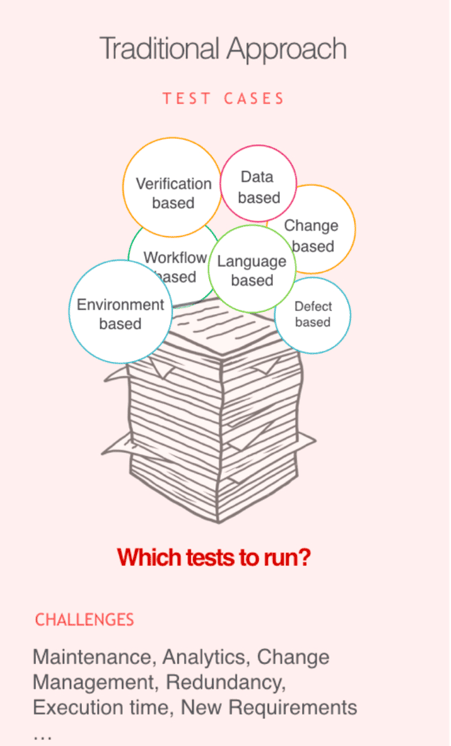Let’s take a real-life scenario from one of our banking customers. Their web banking application has an upcoming release that has a combination of bug fixes, enhancements, and certain API changes. Since it’s a fairly mature application, it has a repository of test assets with approximately 1000 manual test cases and 200 automation scripts. These assets are part of an ALM tool repository. These test assets in the past were tied to requirements, managed in a separate tool, however, during the years and multiple releases, the requirements traceability does not exist anymore.
Test planning is kicked off, and it’s time to figure out what Test Cases are impacted in manual and automation assets. And remember in reality these test assets do not trace to Requirements.

I’m positive this situation will sound familiar to you. Change Impact is a completely manual process today which is time-consuming and error-prone. Not to mention, test cases that are not relevant, never get deleted to avoid the risk. This has a snowball effect and your test case repository is ever-expanding, giving you a false perception of quality. A higher count of test case does not relate to better coverage or higher quality. In reality, Test case count with the manual process of Change Management is misleading, and most of the effort in “maintaining” this repository is going down the drain.
Normally Test suites are manually created based on this change impact analysis. In most cases we over-test, just to be sure we lower our risk.
Adopting true Agility would mean bringing efficiency and automating this critical change management process.
Enter the era of accelQ Universe with Change Bots
accelQ approaches this uniquely at both test case scenario level as well as at the automation script level. I talk about script level change management in another post. accelQ’s App universe concept bakes in the modularity and creates test scenarios that directly relate to components of application and business process. The relationships between these components are a real and direct representation of the application, its business rules and the end-to-end flow including API calls. This referential integrity is the core of bringing automation to the change management process. accelQ’s change bots are able to do real-time path analysis for any business process change to exactly nail down what scenarios are impacted. Not just that, the exact step within each impacted test case is identified reducing the change management effort by 40%. And you can propagate this business process change across all your test assets knowing exactly the impact, allowing you to change logic with precision.


In addition to a Universe guided automated change management, accelQ’s approach has decoupled the concept of test scenarios from test cases. Test cases in accelQ are auto-generated for all permutations and combinations needed for optimal coverage. We are challenging the whole notion of the traditional test case count driven approach and you can read more about it here. With this approach, accelQ’s test cases are dynamic and change effort is relative to only scenario’s representing business process under validation, and not data combinations and variations that need to be tested. Learn more about our self-healing automation that really hits the ball out of the park. Start your free trial now.































